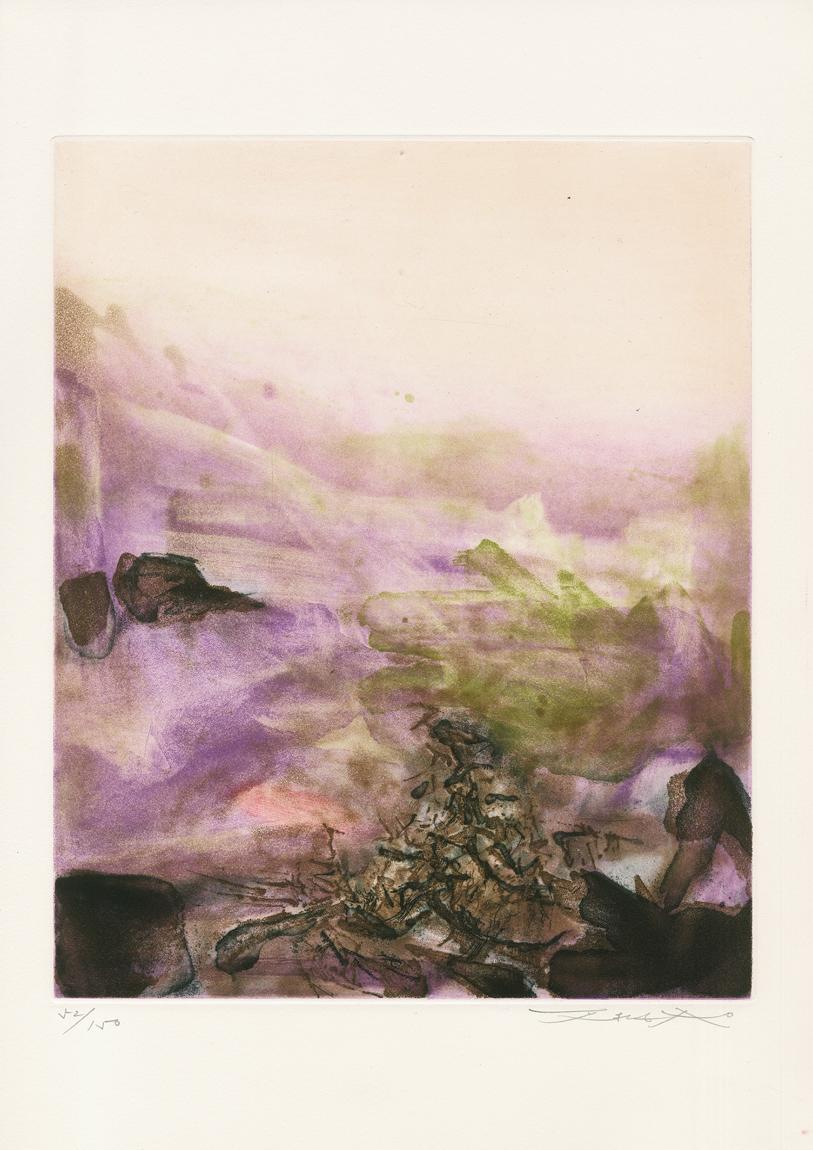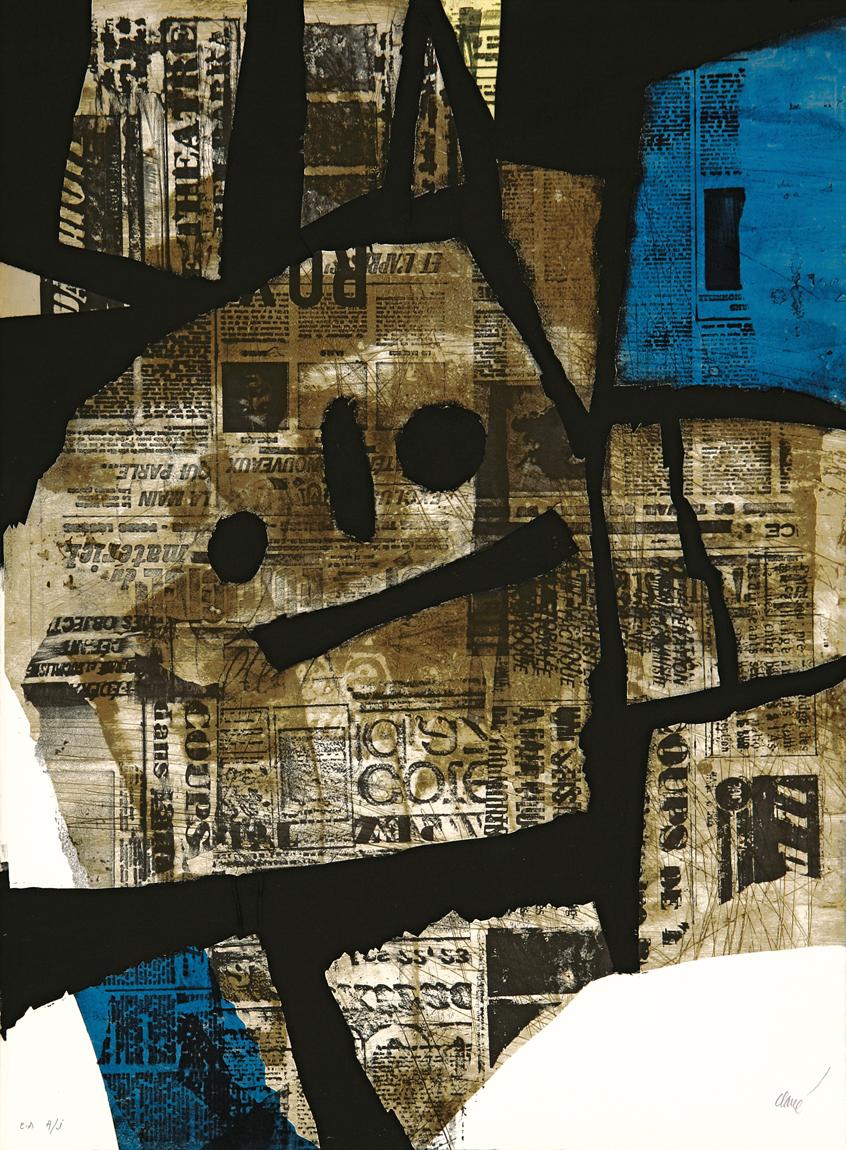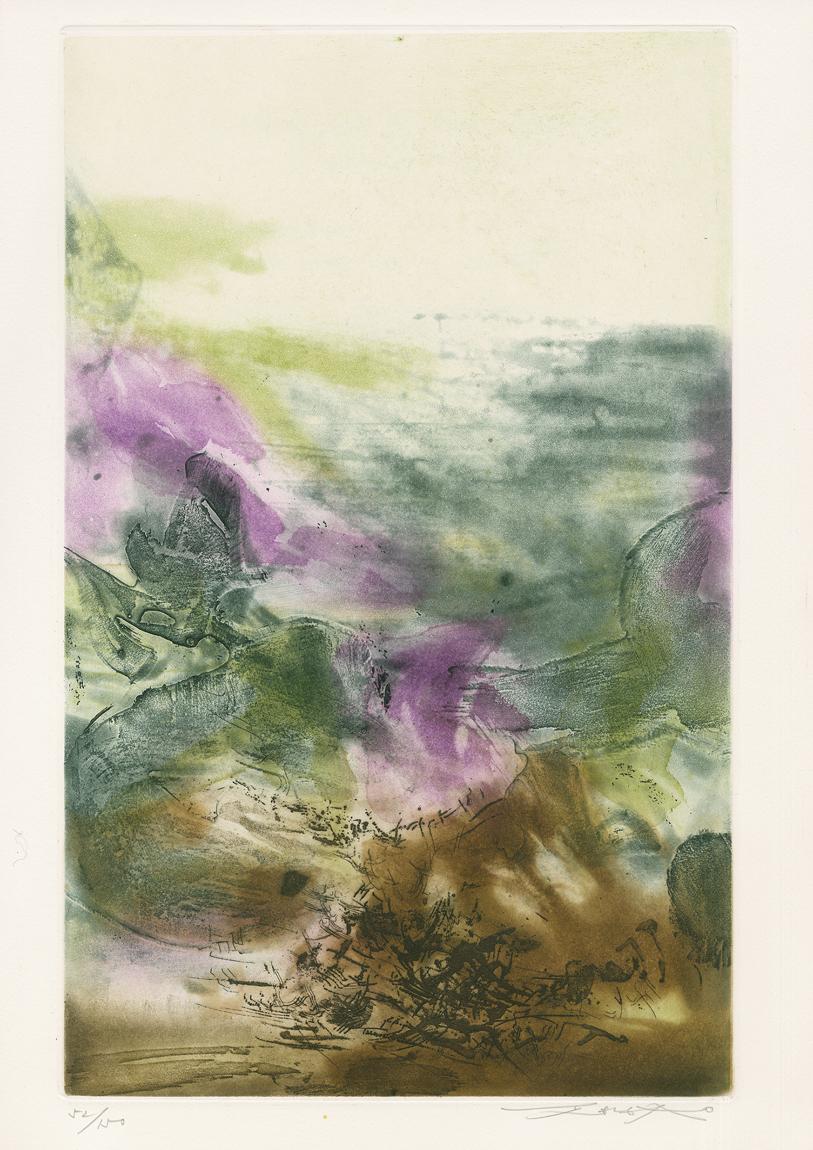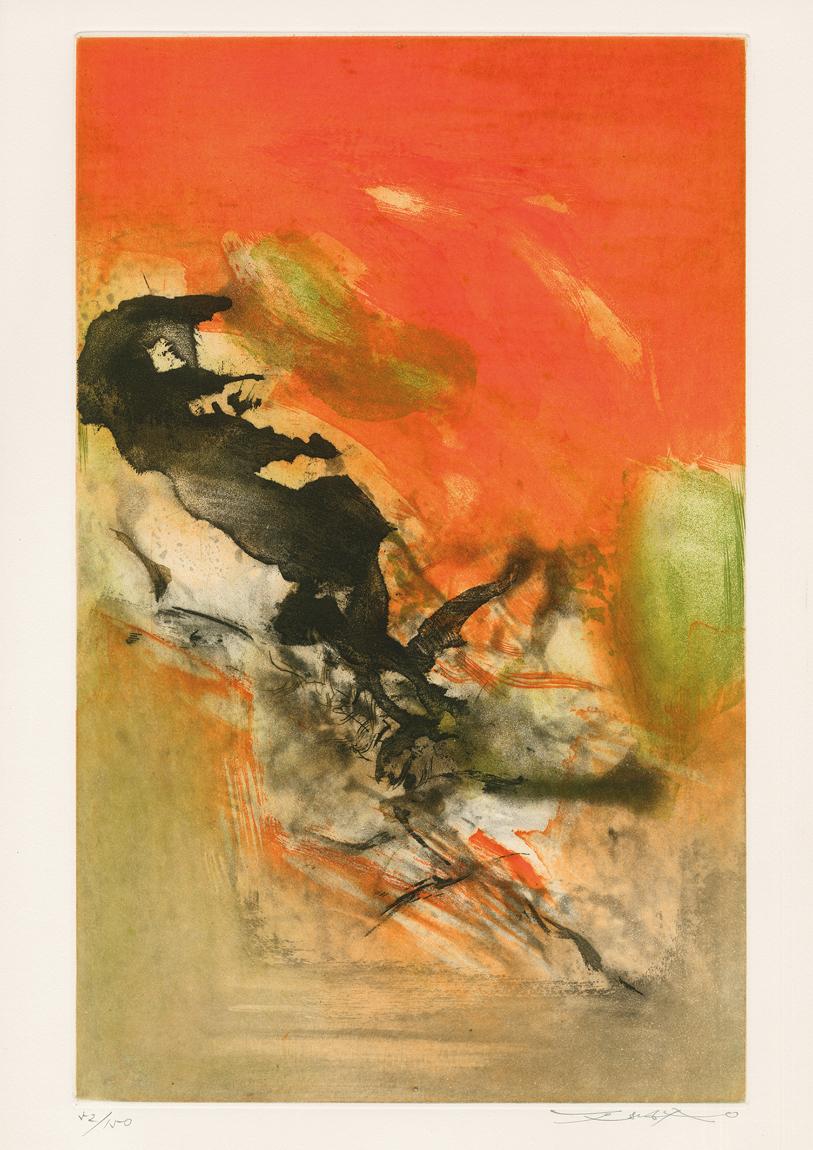Items Similar to Untitled I
Want more images or videos?
Request additional images or videos from the seller
1 of 9
Johnny FriedlaenderUntitled Ic.1970
c.1970
About the Item
This artwork "Untitled I" c.1970 in an original color aquatint on Arches paper by noted Polish artist Johnny Friedlaender, 1912-1992. It is hand signed and numbered 128/135 in pencil by the artist. The image (plate mark) size is 8.35 x 6.15 inches, sheet size is 18.75 x 13 inches. With the blind stamp of the publisher, Horn Editions, New York. With full margin. It is in excellent condition, has never been framed.
About the artist:
Johnny Friedlaender (26 December 1912 – 18 June 1992) was a leading 20th century artist, whose works have been exhibited in Germany, France, Netherlands, Italy, Japan and the United States. He has been influential upon other notable artists, who were students in his Paris gallery. His preferred medium of aquatint etching is a technically difficult artistic process, of which Friedlaender has been a pioneer.
Johnny Gotthard Friedlaender was born in Pless (Silesia) and his early studies were in Breslau under Otto Mueller. In 1936 Friedlaender journeyed to Czechoslovakia, Switzerland, Austria, France and Belgium. At the Hague he held a successful exhibition of etchings and watercolours. He fled to Paris in 1937 as a political refugee of the Nazi regime with his young wife, who was an actress. In that year he held an exhibition of his etchings which included the works: L ‘Equipe and Matieres et Formes. From 1939 to 1943 he was interned in a series of concentration camps, but survived against poor odds.
After freedom in 1944 Friedlaender began a series of twelve etchings entitled Images du Malheur with Sagile as his publisher. In the same year he received a commission to illustrate four books by Freres Tharaud of the French Academy. In 1945 he performed work for several newspapers including Cavalcade and Carrefour. In the year 1947 he produced the work Reves Cosmiques and in that same year he became a member of the Salon de Mai, which position he held until 1969. In the year 1948 he began a friendship with the painter Nicolas de Stael and held his first exhibition in Copenhagen at Galerie Birch. The following year he showed for the first time in Galerie La Hune in Paris. After living in Paris for 13 years, Friedlaender became a French citizen in 1950.
Friedlaender expanded his geographic scope in 1951 and exhibited in Tokyo in a modern art show. In the same year he was a participant in the XI Trienale in Milan, Italy. By 1953 he had produced works for a one man show at the Museum of Neuchâtel and exhibited at the Galerie Moers in Amsterdam, the II Camino Gallery in Rome, in São Paulo, Brazil and in Paris. He was a participant of the French Italian Art Conference in Turin, Italy that same year.
Friedlaender accepted an international art award in 1957, becoming the recipient of the Biennial Kakamura Prize in Tokyo. In 1959 he received a teaching post awarded by UNESCO at the Museum of Modern Art in Rio de Janeiro. By 1968 Friedlaender was travelling to Puerto Rico, New York and Washington, D.C. to hold exhibitions. That year he also purchased a home in the Burgundy region of France. 1971 was another year of diverse international travel including shows in Bern, Milan, Paris, Krefeld and again New York. In the latter city he exhibited paintings at the Far Gallery, a venue becoming well known for its patronage of important twentieth century artists.
1978 brought a retrospective of Friedlaender's works at the Musee d’Art Moderne de la Ville de Paris. He was awarded the Lovis Corinth Prize in Regensburg three years later. On his 75th birthday, Friedlaender was given a retrospective in the Bremen Art Museum. On his 80th birthday he held a retrospective exhibition in Bonn at the municipal council offices. Friedlaender died in Paris at the age of 89.
- Creator:Johnny Friedlaender (1912 - 1992, Polish)
- Creation Year:c.1970
- Dimensions:Height: 19.75 in (50.17 cm)Width: 13 in (33.02 cm)Depth: 0.01 in (0.26 mm)
- Medium:
- Movement & Style:
- Period:
- Condition:
- Gallery Location:San Francisco, CA
- Reference Number:
About the Seller
5.0
Platinum Seller
These expertly vetted sellers are 1stDibs' most experienced sellers and are rated highest by our customers.
Established in 1999
1stDibs seller since 2017
683 sales on 1stDibs
Typical response time: 1 hour
- ShippingRetrieving quote...Ships From: San Francisco, CA
- Return PolicyA return for this item may be initiated within 7 days of delivery.
More From This SellerView All
- Untitled CompositionBy Antoni TàpiesLocated in San Francisco, CAArtist: Antoni Tapies – Spanish (1923- 2012) Title: Untitled, from Paroles Peintes IV, published by O. Lazar-Vernet, Paris Date: 1970 Medium: Etching and aquatint in colors on BFK Ri...Category
1970s Abstract Abstract Prints
MaterialsEtching, Aquatint
- Son AbrinesBy Joan MiróLocated in San Francisco, CA"Son Abrines" Original etching with aquatint printed on Guarro paper. Ink stamp signed, numbered 23/75 in pencil. Also hand signed in pencil on the back by the grand son of the artis...Category
1980s Abstract Abstract Prints
MaterialsAquatint
- "Color and Black" Large colors etching with aquatint, framedBy Sol LeWittLocated in San Francisco, CAThis artwork titled "Color and Black #3" 1991 is a colors etching with spit bit aquatint on Somerset textured white paper by renown artist Sol (Solomon) Le Witt, 1928-2007. It is and signed and numbered 11/15 in pencil by the artist. Whit the blind stamp of the publisher/printer at the lower right corner. The image size is 22.75 x 22.75 inches, paper sheet is 40.75 x 39.75 inches, Framed size is 43.25 x 42,5 inches. Published by Crown Point Press, San Francisco. Printed by Lawrence Hamin, Lothar Osterburg, Paul Mullowney and Pamela Paulson at Crown Point Press, San Francisco. Referenced and pictured in the artist's catalogue raisonne #1991.07, plate #03. Custom Framed in a wooden black frame, floated on a white backing, with white spacer. It is in excellent condition. About the artist: Known for his modular white cube sculpture, geometric drawings and abstract design paintings including many wall paintings that took teams of people to execute, Sol LeWitt was a major promoter of dominant post World War II Conceptualism and Minimalism. He used geometric shapes and lines to challenge his viewers, and sometimes they seemed logical and other times they seemed to have no basis in either reason or reality. Although he was highly active in New York City, he shied away from any semblance of art celebrity life style and spent much of his later life working from his home and studio in Chester, Connecticut. At the beginning of his career when he was gaining notoriety, conservative critics panned him fiercely. Seeking to get away from the frenetic activity of the New York art scene, he went to Spoleto, Italy in the 1980s and remained there for many years. The influence of Italian culture seemed to lend a new opulent quality to his work, and also the launching of his wall paintings, which he called drawings even though they were done with acrylic paint. "He began making colored flagstone patterns, spiky sculptural blobs and ribbons of color, like streamers on New Year's Eve, often as enormous decorations for buildings around the world. It was if he had devised a latter-day kind of Abstract Expressionism . . ." (Kimmelman) Of his personal modesty it was written: "He tried to suppress all interest in him as opposed to his work; he turned down awards and was camera-shy and reluctant to grant interviews. He particularly disliked the prospect of having his photograph in the newspaper." (Kimmelman) Sol LeWitt was born in Hartford, Connecticut to Russian immigrant parents. His father, a doctor, died when Sol was age six, and he and his mother then went to live with an aunt in New Britain, Connecticut. His mother encouraged his art talent, and enrolled him in classes at the Wadsworth Atheneum. LeWitt's subsequent residence in Chester, after he was a well-known artist, was near the Atheneum, and he became a strong supporter of that institution including the securing of a long time loan to it of a highly prestigious private collection of modern art. LeWitt earned a B.F.A. degree from Syracuse University in 1949, and then was drafted in the Korean War. His special assignment was making posters for the Special Services. From 1955 to 1956, he worked as a graphic designer for architect I.M. Pei, who was beginning his career. He also did pasteups for Seventeen magazine...Category
Late 20th Century Abstract Abstract Prints
MaterialsEtching, Aquatint
- "Curvy Brushstrokes" Large etching with aquatint, framedBy Sol LeWittLocated in San Francisco, CAThis artwork titled "Curvy Brushstrokes" 1997 is a colors etching with sugar lift aquatint on Somerset textured white paper by renown artist Sol (Solomon) LeWitt, 1928-2007. It is hand signed and numbered 1/15 in pencil by the artist. The image size is 29.90 x 39.90 inches, paper sheet size is 40.5 x 49.80 inches, framed size is 43.75 x 53 inches. Published by Crown Point Press, San Francisco, printed by Dana Sywulak, assisted by Dena Schneleit, Mary Andrews and Case Hudson at Crown Press, San Francisco. Referenced and pictured in the artist's catalogue raisonne, plate #1997.07. Custom framed in a wooden black frame, floated on white backing, with white spacer. It is in excellent condition, the frame has minor very small restorations, practically invisible. About the artist: Known for his modular white cube sculpture, geometric drawings and abstract design paintings including many wall paintings that took teams of people to execute, Sol LeWitt was a major promoter of dominant post World War II Conceptualism and Minimalism. He used geometric shapes and lines to challenge his viewers, and sometimes they seemed logical and other times they seemed to have no basis in either reason or reality. Although he was highly active in New York City, he shied away from any semblance of art celebrity life style and spent much of his later life working from his home and studio in Chester, Connecticut. At the beginning of his career when he was gaining notoriety, conservative critics panned him fiercely. Seeking to get away from the frenetic activity of the New York art scene, he went to Spoleto, Italy in the 1980s and remained there for many years. The influence of Italian culture seemed to lend a new opulent quality to his work, and also the launching of his wall paintings, which he called drawings even though they were done with acrylic paint. "He began making colored flagstone patterns, spiky sculptural blobs and ribbons of color, like streamers on New Year's Eve, often as enormous decorations for buildings around the world. It was if he had devised a latter-day kind of Abstract Expressionism . . ." (Kimmelman) Of his personal modesty it was written: "He tried to suppress all interest in him as opposed to his work; he turned down awards and was camera-shy and reluctant to grant interviews. He particularly disliked the prospect of having his photograph in the newspaper." (Kimmelman) Sol LeWitt was born in Hartford, Connecticut to Russian immigrant parents. His father, a doctor, died when Sol was age six, and he and his mother then went to live with an aunt in New Britain, Connecticut. His mother encouraged his art talent, and enrolled him in classes at the Wadsworth Atheneum. LeWitt's subsequent residence in Chester, after he was a well-known artist, was near the Atheneum, and he became a strong supporter of that institution including the securing of a long time loan to it of a highly prestigious private collection of modern art. LeWitt earned a B.F.A. degree from Syracuse University in 1949, and then was drafted in the Korean War. His special assignment was making posters for the Special Services. From 1955 to 1956, he worked as a graphic designer for architect I.M. Pei, who was beginning his career. He also did pasteups for Seventeen magazine...Category
Late 20th Century Abstract Abstract Prints
MaterialsEtching, Aquatint
- Process LandscapeBy Tom MarioniLocated in San Francisco, CAArtist: Tom Marioni – American (1937- ) Title: Process Landscape 1998 Year: 1998 Medium: Color spit bite aquatint Image size: 15.75 x 10 inches. Paper size: 20 x 16 inches Framed size: 21.75 x 17.75 inches Signature: Signed, dated lower right Edition: 50. This one: 24/50. Published by: Crown Point Press Printed by: Paul Mullowney Condition: Excellent Frame: Framed in maple frame and plexiglas. Frame in fair to good condition with some small scratches. Tom Marioni was born in 1937 in Cincinnati, Ohio, attended the Cincinnati Art Academy, and in 1959 moved to San Francisco, where he still lives. His first sound work, One Second Sculpture, 1969, was celebrated in the 2005 Lyon Biennial as presaging the work of many artists today who use sound and duration as subjects. His first museum show was in 1970 at the Oakland Museum of California. Titled “The Act of Drinking Beer with Friends is the Highest Form of Art,” it was an early example of social art as a sculpture action. Over the years, Marioni was invited to repeat the work in various contexts around the world. In 1970 Marioni founded the Museum of Conceptual Art (MOCA), which he described at the time as “a large-scale social work of art.” Until the museum closed in 1984, he organized many groundbreaking shows, including “Sound Sculpture As” in 1970. MOCA has entered history as one of the first alternative art spaces. Marioni had one-person shows in several significant venues for early conceptual art, among them the Richard Demarco Gallery in Edinburgh in 1972 and Gallery Foksal in Warsaw in 1975. In 1977 he had a solo show, “The Sound of Flight,” at the de Young Museum in San Francisco. He has done installation/performance works at the Whitechapel Gallery in London (1972), the Institute of Contemporary Art in London (1973), the Centre Georges Pompidou in Paris (1980), and the Folkwang Museum in Essen, Germany (1982), among other museums. He has produced sound works for radio stations KPFA in Berkeley and WDR in Cologne, Germany. In 1996 he organized The Art Orchestra and the group performed at the Legion of Honor Museum in San Francisco. Marioni was included in “For Eyes and Ears” (1980) at the Academy of Fine Arts in Berlin, “Live to Air” (1982) at the Tate Gallery in London, and “From Sound to Image” (1985) at the Stuttgart Staatsgalerie in Germany. His work was shown in “Out of Actions: Between Performance and the Object” (1998) at the Museum of Contemporary Art in Los Angeles, and “The Third Mind: American Artists Contemplate Asia,” (2009) at the Guggenheim Museum in New York City. Drawing is central to Marioni’s art, and in 1999 he had a drawing retrospective, with a catalog, at the Mills College Art Museum in Oakland. In 2006 the Contemporary Art Center in Cincinnati presented a survey of his work and published a catalog. Marioni is the author of Beer, Art and Philosophy, 2003, a memoir, also Writings on Art 1969-1999, and Fabliaux Tom Marioni Fairy Tales. He was editor/designer of VISION magazine published by Crown Point Press, 1975-1981. Issues were titled “California,” “Eastern Europe,” “New York City,” “Word Of Mouth,” (phonograph records) and “Artist’s Photographs,” and published prints, since 1974. Tom Marioni received a Guggenheim Fellowship in 1981 and three grants from the National Endowment for the Arts during the 1970s. His work is in the collections of the San Francisco Museum of Modern Art, the Museum of Modern Art in New York, the Stadtische Kunsthalle in Mannheim, Germany, the Pompidou Center in Paris, and other museums. He is represented by the Anglim Gilbert Gallery...Category
1990s Abstract Impressionist Abstract Prints
MaterialsPaper, Aquatint
- Untitled #1Located in San Francisco, CAThis artwork, Untitled #1 is an original color aquatint on Wove paper by noted Mexican artist Luis Lopez Loza, b.1939. It is hand signed and numbered 4/50 i...Category
Late 20th Century Abstract Abstract Prints
MaterialsAquatint
You May Also Like
- Untitled Sheet 5 from "Canto Pisan" by Zao Wou-Ki, Abstract, Lilac, Black, GreenBy Zao Wou-KiLocated in Köln, DEAquatint in colours by Wou-Ki Zao Untitled Sheet 5 from "Canto Pisan" (portfolio with poems by Ezra Pound), 1972 50,5 x 33 cm Copy 52/150 Edition of 254 ...Category
1970s Abstract Abstract Prints
MaterialsAquatint
- "Homenaje a Picasso" - 20th Century Print by Eduardo Chillida, AbstractionBy Eduardo ChillidaLocated in Köln, DEThis is one of the most important motifs in the graphic oeuvre of Chillida. The Spanish artist is very well known for his large-scale sculptures which can be found in public as well ...Category
1970s Abstract Abstract Prints
MaterialsAquatint
- "Servando V" by Antoni Clavé, Black, Blue, AbstractBy Antoni ClavéLocated in Köln, DEColor etching with carborundum by Antoni Clavé "Servando V", 1973 66 x 57 cm Copy Artist's Proof Edition of 95 Antoni Clavé (Barcelona 1913 - 2005 Sain...Category
1970s Abstract Abstract Prints
MaterialsAquatint, Etching
- Untitled Sheet 7 from "Canto Pisan" by Zao Wou-Ki, Abstract Print, Lilac, GreenBy Zao Wou-KiLocated in Köln, DEAquatint in colours by Zao Wou-Ki Untitled Sheet 7 from "Canto Pisan" (portfolio with poems by Ezra Pound), 1972 50,5 x 33 cm Copy 52/150 Edition of 254 Zao Wou-Ki (Peking 1921 –...Category
1970s Abstract Abstract Prints
MaterialsAquatint
- Abstract Print from "Series II" by Joan Miró, Graphic artwork, Black and WhiteBy Joan MiróLocated in Köln, DEfrom "Series II" - Joan Miró, Graphic artwork, Miró, Black and White Aquatint etching from 1947, printed in 1952-1953, 50,5 x 64,7 cm, Edition of 13, in complete approx. 20 Exemplars...Category
1940s Abstract Abstract Prints
MaterialsAquatint
- Untitled Sheet 2 from "Canto Pisan" by Zao Wou-Ki, Orange, Abstract, Black, GreenBy Zao Wou-KiLocated in Köln, DEAquatint in colours by Zao Wou-Ki No Title Sheet 2 from "Canto Pisan" (portfolio with poems by Ezra Pound), 1972 50,5 x 33 cm Copy 52/150 Edition of 254 ...Category
1970s Abstract Abstract Prints
MaterialsAquatint





